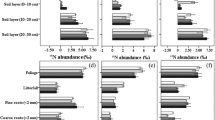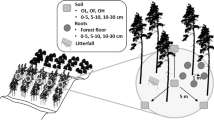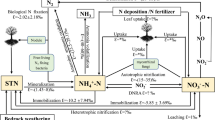Abstract
15N natural abundances of soil total N, roots and mycorrhizas were studied in surface soil profiles in coniferous and broadleaved forests along a transect from central to northern Europe. Under conditions of N limitation in Sweden, there was an increase in δ15N of soil total N of up to 9% from the uppermost horizon of the organic mor layer down to the upper 0–5 cm of the mineral soil. The δ15N of roots was only slightly lower than that of soil total N in the upper organic horizon, but further down roots were up to 5% depleted under such conditions. In experimentally N-enriched forest in Sweden, i.e. in plots which have received an average of c. 100 kg N ha−1 year−1 for 20 years and which retain less than 50% of this added N in the stand and the soil down to 20 cm depth, and in some forests in central Europe, the increase in δ15N with depth in soil total N was smaller. An increase in δ15N of the surface soil was even observed on experimentally N-enriched plots, although other data suggest that the N fertilizer added was depleted in15N. In such cases roots could be enriched in15N relative to soil total N, suggesting that labelling of the surface soil is via the pathway: — available pools of N-plant N-litter N. Under N-limiting conditions roots of different species sampled from the same soil horizon showed similar δ15N. By contrast, in experimentally N-enriched forest δ15N of roots increased in the sequence: ericaceous dwarf shrubs<Scots pine<grass, suggesting increasing use of inorganic N along the sequence. Complementary studies at the major transect sites had shown that 90–99% of fine tree roots had ectomycorrhizas (ECMs). ECMs were 2% more enriched than corresponding non-mycorrhizal fine roots. Fungal sheaths stripped off ECMs were 2.4–6.4 enriched relative to the remaining root core. It is suggested that a flux of N through ECMs to aboveground parts in N-limited forests would leave 15N enriched compounds in fungal material, which could contribute to explain the observed δ15N profiles if fungal material is enriched, because it is a precursor of stable organic matter and recalcitrant N. This could act in addition to the previous explanation of the isotopically lighter soil surface in forests: plant uptake of 15N-depleted N and its redeposition onto the soil surface by litter-fall.
Similar content being viewed by others
References
Aber JD, Nadelhoffer KJ, Steudler P, Melillo JM (1989) Nitrogen saturation in northern forest ecosystems. BioScience 39:378–386
Abuzinadah RA, Finlay RD, Read DJ (1986) The role of proteins in the nitrogen nutrition of ectomycorrhizal plants. II. Utilization of protein by mycorrhizal plants of Pinus contorta. New Phytol 103:495–506
Barrie A, Lemley M (1989) Automated N-15/C-13 analysis of biological materials. Int Lab Tech 19:82–91
Feigin A, Shearer GB, Kohl DH, Commoner B (1974) The amount and nitrogen-15 content of nitrate in soil profiles from two central Illinois fields in a corn-soybean rotation. Proc Soil Sci Soc Am 38:465–471
Garten CT Jr (1993) Variation in foliar 15N abundance and the availability of soil nitrogen on Walker Branch Watershed. Ecology 74:2098–2113
Garten CT Jr, Miegrot H van (1994) Relationships between soil nitrogen dynamics and natural 15N abundance in plant foliage from the Great Smoky Mountain National Park. Can J For Res 24:1636–1645
Gebauer G, Dietrich P (1993) Nitrogen isotope ratios in different compartments of a mixed stand of spruce, larch and beech trees and of understorey vegetation including fungi. Isotopenpraxis 29:35–44
Gebauer G, Schulze E-D (1991) Carbon and nitrogen isotope ratios in different compartments of a healthy and a declining Picea abies forest in the Fichtelgebirge, NE Bavaria. Oecologia 87:198–207
Gebauer G, Rehder H, Wollenweber B (1988) Nitrate, nitrate reduction and organic nitrogen in plants from different ecological and taxonomical groups of Central Europe. Oecologia 75:371–385
Gigon A, Rorison IH (1976) The response of some ecologically distinct plant species to nitrate and to ammonium nitrogen. J Ecol 60:93–112
Grime GP, Hodgson JG, Hunt R (1988) Comparative plant ecology: a fundamental approach to common British species. Unwin Hyman, London
Handley LL, Raven JA (1992) The use of natural abundance of nitrogen isotopes in plant physiology and ecology. Plant Cell Environ 15:965–985
Harley JL, Smith SE (1983) Mycorrhizal symbiosis. Academic Press, London
Harper LA, Sharpe RR, Langdale GW, Giddens JE (1987) Nitrogen cycling in a wheat crop: soil, plant and aerial nitrogen transport. Agron J 79:965–973
Högberg P (1991) Forests losing large quantities of nitrogen have elevated 15N:14N ratios. Oecologia 84:229–231
Högberg P (1991) Development of 15N enrichment of a nitrogenfertilized forest soil-plant system. Soil Biol Biochem 23:335–338
Högberg P, Johannisson C (1993) 15N abundance of forests is correlated with losses of nitrogen. Plant Soil 157:147–150
Högberg P, Johannisson C, Högberg M, Högbom L, Näsholm T, Hällgren J-E (1995) Measurements of abundances of 15N and 13C as tools in retrospective studies of N balances and water stress in forests: A discussion of preliminary results. Plant Soil 168/169:125–133
Högberg P, Johannisson C, Nicklasson H, Högbom L (1990) Shoot nitrate reductase activities of field-layer species in different forest types. I. Preliminary surveys in northern Sweden. Scand J For Res 5:449–456
Högbom L, Högberg P (1991) Nitrate nutrition of Deschampsia flexuosa (L.) Trin. in relation to nitrogen deposition in Sweden. Oecologia 87:488–494
Ingelög T, Nohrstedt H-Ö (1993) Ammonia formation and soil pH increase by decomposing fruit bodies of macrofungi. Oecologia 93:449–451
Jones HE, Högberg P, Ohlsson H (1994) Nutritional assessment of a forest fertilisation experiment in northern Sweden by root bioassays. For Ecol Manage 64:59–69
Leake JR, Read DJ (1990) Chitin as a nitrogen source for mycorrhizal fungi. Mycol Res 94:993–995
Lee JA, Stewart GR (1978) Ecological aspects of nitrogen metabolism. Adv Bot Res 6:1–43
Mariotti A, Pierre D, Vedy JC, Bruckert S, Guillemot J (1980) The abundance of natural nitrogen-15 in the organic matter of soils along an altitudinal gradient. Catena 7:293–300
Meints VW, Boone LV, Kurz LT (1975) Natural 15N abundance in soil, leaves, and grain as influenced by long term additions of fertilizer N at several rates. J Environ Qual 4:486–490
Melillo JM, Aber JD, Linkins AE, Ricca A, Fry B, Nadelhoffer KJ (1989) Carbon and nitrogen dynamics along the decay continuum: plant litter to soil organic matter. Plant Soil 115:189–198
Mizutani H, Hasegawa H, Wada E (1986) High nitrogen isotope ratios for soils of seabird rookeries. Biogeochemistry 2:221–247
Mizutani H, Kabaya Y, Wada E (1991) Linear correlation between latitude and soil 15N enrichment at seabird rookeries. Naturwissenschaften 78:34–36
Nadelhoffer KJ, Fry B (1988) Controls on natural nitrogen-15 and carbon-13 abundances in forest soil organic matter. Soil Sci Soc Am J 52:1633–1640
Nadelhoffer KJ, Fry B (1994) Nitrogen isotope studies in forest ecosystems. In: Lajtha K, Michener R (eds) Stable isotopes in ecology and environmental science. Blackwell, Boston, pp 23–44
Nadelhoffer KJ, Shaver G, Fry B, Giblin A, Johnson L, McKane R (1996) 15N natural abundance and N use by tundra plants. Oecologia, in press
Nömmik H, Pluth DJ, Larsson K, Mahendrappa MK (1994) Isotopic fractionation accompanying fertilizer nitrogen transformations in soil and trees of a Scots pine ecosystem. Plant Soil 58:169–182
Nye PH, Tinker PB (1977) Solute movement in the soil-root system. Blackwell, Oxford
Paul EA, Clark FE (1988) Soil microbiology and biochemistry. Academic Press, San Diego
Riga A, Praag HJ van, Brigode N (1971) Rapports isotopique naturel de l'azote dans quelques sols forestiers et agricoles de Belgique soumis a divers traitments culturaux. Geoderma 6:213–222
Schulze E-D, Chapin FSIII, Gebauer G (1994) Nitrogen nutrition and isotope differences among life forms at the northern treeline of Alaska. Oecologia 100:406–412
Shearer GB, Kohl DH (1986) N2 fixation in field settings: estimations based on 15N natural abundance. Aust J Plant Phys 13:699–757
Shearer GB, Duffy J, Kohl DH, Commoner B (1974) A steady state model of isotopic fractionation accompanying nitrogen transformations in soils. Proc Soil Sci Soc Am 38:315–322
Sutherland RA, Kessel C van, Farrell RE, Pennock DJ (1993) Landscape-scale variation in plant and soil nitrogen-15 natural abundance. Soil Sci Soc Am J 57:169–178
Tamm C-O (1989) Comparative and experimental approaches to the study of acid deposition effects on soils as substrate for forest growth. Ambio 18:184–191
Tamm C-O, Aronsson A, Popovic B (1995) Nitrogen saturation in a long-term forest experiment with annual additions of nitrogen. Water Air Soil Pollut, in press
Author information
Authors and Affiliations
Rights and permissions
About this article
Cite this article
Högberg, P., Högbom, L., Schinkel, H. et al. 15N abundance of surface soils, roots and mycorrhizas in profiles of European forest soils. Oecologia 108, 207–214 (1996). https://doi.org/10.1007/BF00334643
Received:
Accepted:
Issue Date:
DOI: https://doi.org/10.1007/BF00334643




